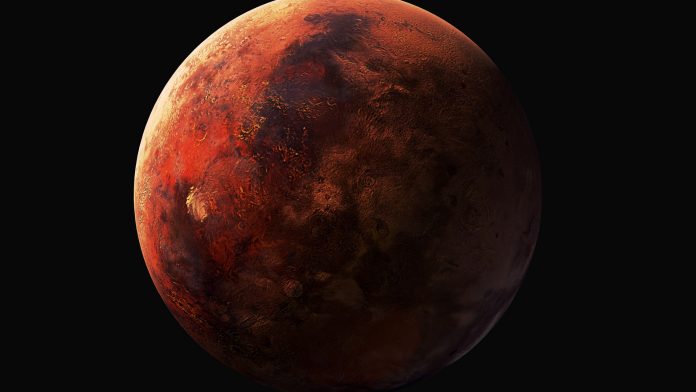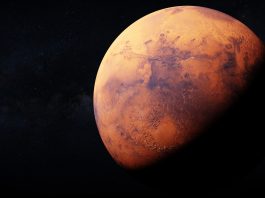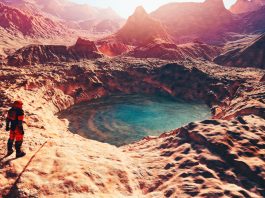A new study conducted by Washington University in St. Louis suggests that the habitability of Mars is limited by its small size, which means it cannot hold large amounts of water.
The presence of water is an essential condition of life on Earth and other planets. In its early history, the Red Planet had an abundance of water present. However, currently Mars does not have liquid water on its surface. Novel research from scientists at Washington University has now uncovered that the core reason behind this habitability limiting factor: Mars does not hold water because it is too small.
Water-rich history on Mars
Previous remote sensing studies and examinations of the meteorites of Mars indicate that the planet was once rich in water. Both NASA’s Viking orbiter spacecraft and the Curiosity and Perseverance rovers on the ground returned images of Martian landscapes marked by river valleys and flood channels.
In spite of this evidence, there is no water left on the Red Planet’s surface. The team offered several feasible explanations, such as a weakening of Mars’ magnetic field that could have resulted in the loss of a thick atmosphere.
Now, in novel research published in the Proceedings of the National Academy of Sciences, the researchers have indicated a core reason why Mars currently looks so different to Earth.
“Mars’ fate was decided from the beginning,” explained Kun Wang, assistant professor of earth and planetary sciences in Arts & Sciences at Washington University, senior author of the study. “There is likely a threshold on the size requirements of rocky planets to retain enough water to enable habitability and plate tectonics, with mass exceeding that of Mars.”
Isotopes offer new explanation
For this research, Wang and his team utilised stable isotopes of potassium (K) to approximate the existence, dissemination, and quantity of volatile elements on distinct planetary bodies.
Potassium is a relatively volatile element, but the team decided to employ it as a tracer for more volatile elements and compounds like water. This is a fairly new technique that deviates from earlier attempts to utilise potassium-to-thorium (Th) ratios collected by remote sensing and chemical analysis to establish the number of volatiles Mars once had. In prior research, the team applied a potassium tracer technique to investigate the formation of the moon.
Wang and the group calculated the potassium isotope compositions of 20 formerly verified Martian meteorites, chosen to be representative of the bulk silicate composition of Mars.
By applying this method, the team concluded that Mars lost more potassium and other volatiles than Earth during its formation but preserved more of these volatiles than the moon and asteroid 4-Vesta, two much smaller and drier bodies than Earth and Mars.
The group observed a well-defined correlation between body size and potassium isotopic composition.
“The reason for far lower abundances of volatile elements and their compounds in differentiated planets than in primitive undifferentiated meteorites has been a longstanding question,” commented Katharina Lodders, research professor of earth and planetary sciences at Washington University, a co-author of the study. “The finding of the correlation of K isotopic compositions with planet gravity is a novel discovery with important quantitative implications for when and how the differentiated planets received and lost their volatiles.”
“Martian meteorites are the only samples available to us to study the chemical makeup of the bulk Mars,” Wang said. “Those Martian meteorites have ages varying from several hundred million to four billion years and recorded Mars’ volatile evolution history. Through measuring the isotopes of moderately volatile elements, such as potassium, we can infer the degree of volatile depletion of bulk planets and make comparisons between different solar system bodies.
“It’s indisputable that there used to be liquid water on the surface of Mars, but how much water in total Mars once had is hard to quantify through remote sensing and rover studies alone,” Wang added. “There are many models out there for the bulk water content of Mars. In some of them, early Mars was even wetter than the Earth. We don’t believe that was the case.”
Searching for life on exoplanets
The researchers also noted that their novel findings have significant implications assessing the habitability of planets of other planets in addition to Mars.
A planet being too close to its star can impact the number of volatiles that a planetary body can preserve. This distance-from-star measurement is often factored into indexes of ‘habitable zones’ around stars.
“This study emphasises that there is a very limited size range for planets to have just enough but not too much water to develop a habitable surface environment,” explained Klaus Mezger of the Center for Space and Habitability at the University of Bern, Switzerland, who is also a co-author of the study. “These results will guide astronomers in their search for habitable exoplanets in other solar systems.”
Wang now thinks that, for planets that are within habitable zones, planetary size should be more emphasised and taken into account when considering whether an exoplanet could support life.
“The size of an exoplanet is one of the parameters that is easiest to determine,” Wang concluded. “Based on size and mass, we now know whether an exoplanet is a candidate for life, because a first-order determining factor for volatile retention is size.”









